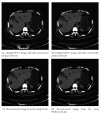Improving spatial adaptivity of nonlocal means in low-dosed CT imaging using pointwise fractal dimension
- PMID: 23606907
- PMCID: PMC3626180
- DOI: 10.1155/2013/902143
Improving spatial adaptivity of nonlocal means in low-dosed CT imaging using pointwise fractal dimension
Abstract
NLMs is a state-of-art image denoising method; however, it sometimes oversmoothes anatomical features in low-dose CT (LDCT) imaging. In this paper, we propose a simple way to improve the spatial adaptivity (SA) of NLMs using pointwise fractal dimension (PWFD). Unlike existing fractal image dimensions that are computed on the whole images or blocks of images, the new PWFD, named pointwise box-counting dimension (PWBCD), is computed for each image pixel. PWBCD uses a fixed size local window centered at the considered image pixel to fit the different local structures of images. Then based on PWBCD, a new method that uses PWBCD to improve SA of NLMs directly is proposed. That is, PWBCD is combined with the weight of the difference between local comparison windows for NLMs. Smoothing results for test images and real sinograms show that PWBCD-NLMs with well-chosen parameters can preserve anatomical features better while suppressing the noises efficiently. In addition, PWBCD-NLMs also has better performance both in visual quality and peak signal to noise ratio (PSNR) than NLMs in LDCT imaging.
Figures



Similar articles
-
Optimized Parallelization for Nonlocal Means Based Low Dose CT Image Processing.Comput Math Methods Med. 2015;2015:790313. doi: 10.1155/2015/790313. Epub 2015 May 19. Comput Math Methods Med. 2015. PMID: 26078781 Free PMC article.
-
Unpaired Low-Dose CT Denoising Network Based on Cycle-Consistent Generative Adversarial Network with Prior Image Information.Comput Math Methods Med. 2019 Dec 7;2019:8639825. doi: 10.1155/2019/8639825. eCollection 2019. Comput Math Methods Med. 2019. PMID: 31885686 Free PMC article.
-
Adaptively Tuned Iterative Low Dose CT Image Denoising.Comput Math Methods Med. 2015;2015:638568. doi: 10.1155/2015/638568. Epub 2015 May 24. Comput Math Methods Med. 2015. PMID: 26089972 Free PMC article.
-
Probabilistic self-learning framework for low-dose CT denoising.Med Phys. 2021 May;48(5):2258-2270. doi: 10.1002/mp.14796. Epub 2021 Mar 17. Med Phys. 2021. PMID: 33621348
-
Basics of iterative reconstruction methods in computed tomography: A vendor-independent overview.Eur J Radiol. 2018 Dec;109:147-154. doi: 10.1016/j.ejrad.2018.10.025. Epub 2018 Oct 26. Eur J Radiol. 2018. PMID: 30527298 Review.
Cited by
-
DMF-Net: a deep multi-level semantic fusion network for high-resolution chest CT and X-ray image de-noising.BMC Med Imaging. 2023 Oct 9;23(1):150. doi: 10.1186/s12880-023-01108-0. BMC Med Imaging. 2023. PMID: 37814250 Free PMC article.
-
CT image denoising methods for image quality improvement and radiation dose reduction.J Appl Clin Med Phys. 2024 Feb;25(2):e14270. doi: 10.1002/acm2.14270. Epub 2024 Jan 19. J Appl Clin Med Phys. 2024. PMID: 38240466 Free PMC article. Review.
-
Applications of nonlocal means algorithm in low-dose X-ray CT image processing and reconstruction: A review.Med Phys. 2017 Mar;44(3):1168-1185. doi: 10.1002/mp.12097. Med Phys. 2017. PMID: 28303644 Free PMC article. Review.
References
-
- Brenner DJ, Hall EJ. Computed tomography-an increasing source of radiation exposure. New England Journal of Medicine. 2007;357(22):2277–2284. - PubMed
-
- Hansen J, Jurik AG. Survival and radiation risk in patients obtaining more than six CT examinations during one year. Acta Oncologica. 2009;48(2):302–307. - PubMed
-
- Brisse HJ, Brenot J, Pierrat N, et al. The relevance of image quality indices for dose optimization in abdominal multi-detector row CT in children: experimental assessment with pediatric phantoms. Physics in Medicine and Biology. 2009;54(7):1871–1892. - PubMed
-
- Weidemann J, Stamm G, Galanski M, Keberle M. Comparison of the image quality of various fixed and dose modulated protocols for soft tissue neck CT on a GE Lightspeed scanner. European Journal of Radiology. 2009;69(3):473–477. - PubMed
Publication types
MeSH terms
LinkOut - more resources
Full Text Sources
Other Literature Sources
Medical

